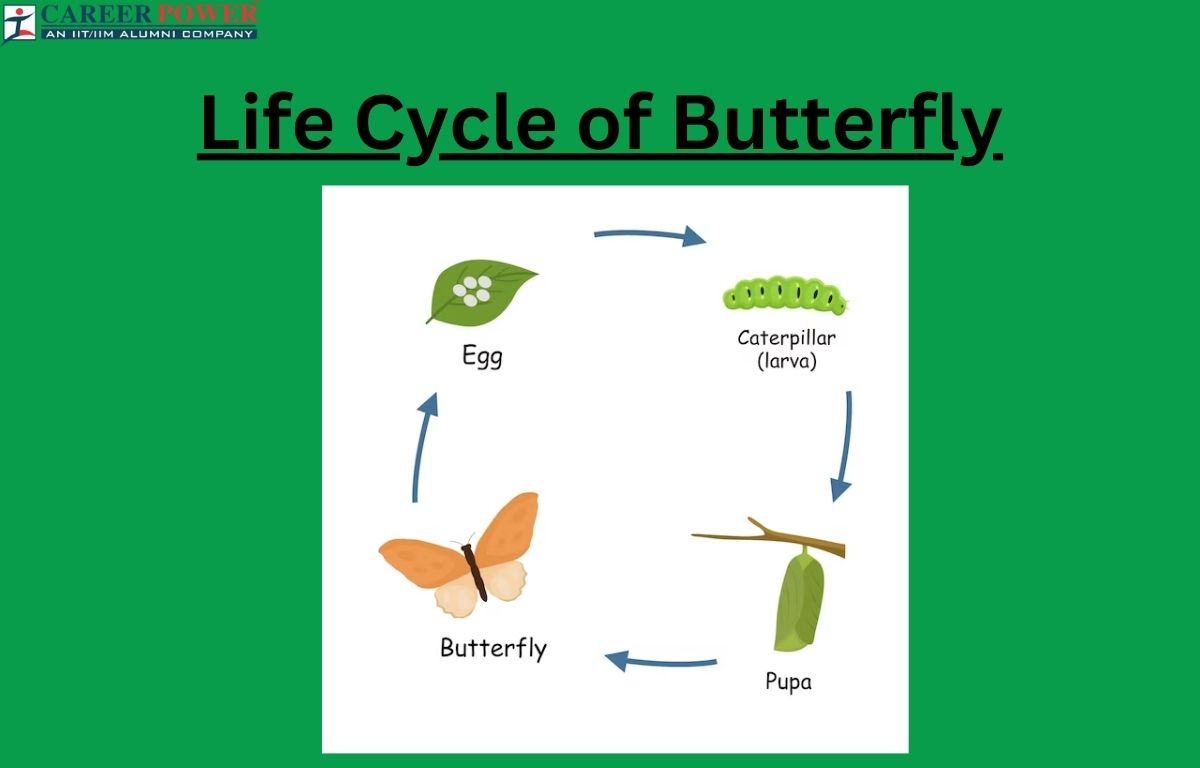A butterfly is an insect with colorful wings. Its life cycle consists of four stages: Eggs, Larva (caterpillar), pupa (chrysalis), and adult. The process begins when a female butterfly lays eggs on plants. The eggs hatch into caterpillars that eat and grow. The caterpillar forms a chrysalis, undergoing metamorphosis inside. Finally, an adult butterfly emerges, ready to flutter and pollinate flowers, continuing the cycle. Other details related to the life cycle of a butterfly have been discussed below in the article.
Define the Life Cycle of a Butterfly
The life cycle of a butterfly undergoes a fascinating transformation in four stages: Egg, Larva (caterpillar), Pupa (chrysalis), and Adult. It all begins when a female butterfly lays tiny eggs on a host plant. From these eggs, caterpillars hatch, representing the larval stages. During this phase, the caterpillar devours leaves and grows rapidly. Once fully grown, it forms a protective chrysalis around itself, marking the pupal stages. Inside the chrysalis, a remarkable metamorphosis occurs, transforming the caterpillar into a butterfly. After a waiting period, the adult butterfly emerges, unfolds its wings, and begins its colorful, winged life. The butterfly then seeks nectar, mates, and lays eggs, starting the cycle anew. This process showcases the wonders of nature’s continuous rebirth and transformation.
Life Cycle of a Butterfly Diagram
The life cycle of a butterfly diagram illustrates the metamorphosis from egg to adult. It begins with the female butterfly laying eggs on a host plant. Once hatched, the larva, or caterpillar consumes food and grows. The pupa stage follows, during which the caterpillar undergoes a dramatic transformation inside a chrysalis. Finally, a fully developed butterfly emerges, completing the remarkable process of metamorphosis.
Stages Involved in the Life Cycle of the Butterfly
The butterfly life cycle consists of four stages: Egg, Larva (Caterpillar), Pupa (Chrysalis), and Adult (Butterfly). This entire process is an adaptation that allows butterflies to exploit different ecological niches during their life cycle, optimizing their chances for survival and reproduction. This transformation from egg to larva to pupa to adult is known as complete metamorphosis and is known as complete metamorphosis and is characteristic of insects in the order Lepidoptera, which includes butterflies and moths.
- Egg:
- The life cycle begins when a female butterfly lays tiny, often round or oval-shaped eggs on the leaves or stems of host plants.
- The choice of host plant is species-specific, as different butterflies prefer specific plants for their eggs.
- Larva (Caterpillar):
- Upon hatching from the egg, the larva, commonly known as a caterpillar, emerges.
- The caterpillar’s main activities are feeding and growing. It voraciously consumes plant material, often the leaves of the host plant.
- The larval stage is characterized by multiple molts, where the caterpillar sheds its exoskeleton to accommodate its increasing size.
- Pupa (Chrysalis):
- When the caterpillar reaches its full size, it undergoes a process known as pupation.
- The pupa also called a chrysalis, is a protective casing formed around the caterpillar. Inside the chrysalis, the insect undergoes a remarkable transformation.
- This stage involves the development of adult structures from the larval body, a process known as metamorphosis.
- Adult (Butterfly):
- The adult butterfly emerges from the chrysalis after the metamorphosis is complete.
- The newly emerged butterfly often has wet and crumpled wings. It must wait for its wings to dray and expand before it can fly.
- The primary goal of the adult butterfly is to reproduce. It seeks a mate, and after mating, the female lays eggs on suitable host plants, restarting the life cycle.
Importance of the Life Cycle of a Butterfly
The life cycle of a butterfly is important for various reasons. It symbolizes transformation and metamorphosis, teaching us about change and growth. Additionally, butterflies play a crucial role in pollination, contributing to the health of ecosystems and agriculture. Here we have discussed a few points on the importance of the life cycle of a butterfly.
- Metamorphosis: The butterfly’s life cycle amplifies a remarkable transformation from egg to larva (caterpillar) to pupa (chrysalis) and finally to an adult butterfly.
- Symbol of Change: It serves as a powerful symbol of change, growth, and renewal, inspiring individuals to embrace transformation in their own lives.
- Ecosystem Health: Butterflies, as pollinators, contribute to the reproduction of many plants, playing a vital role in maintaining biodiversity and supporting healthy ecosystems.
- Environmental Indicator: Monitoring butterfly populations and their life cycle can act as an indicator of environmental health, as they are sensitive to changes in their habitat and climate.
- Educational Value: Studying the life cycle of butterflies provides educational opportunities, foresting an understanding of Biology, ecology, and the interconnectedness of species in nature.



 50 Vegetables Name for Kids in English a...
50 Vegetables Name for Kids in English a...
 Food Chain: Definition, Types, Examples,...
Food Chain: Definition, Types, Examples,...
 Human Respiratory System: Definition, Di...
Human Respiratory System: Definition, Di...













